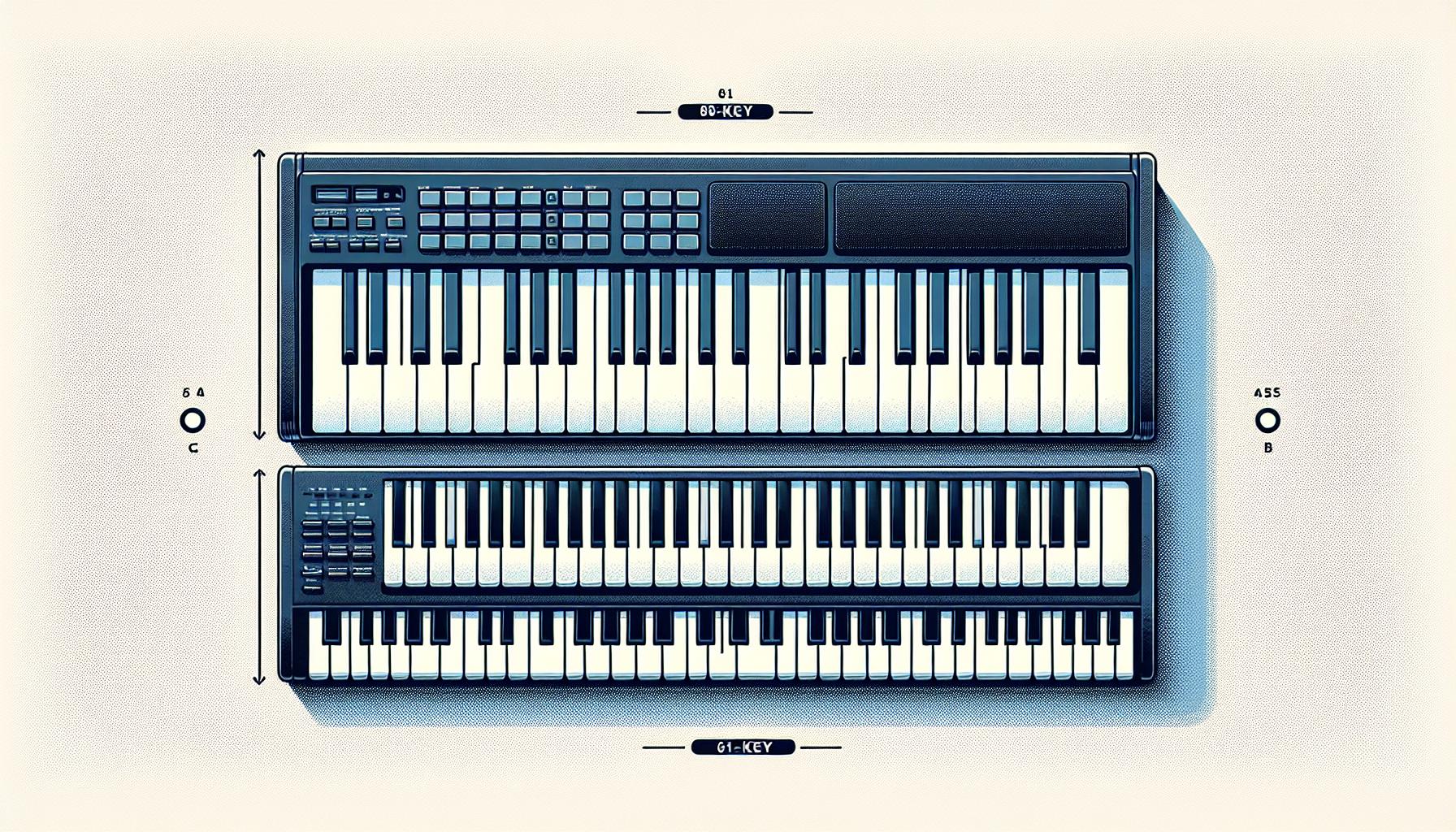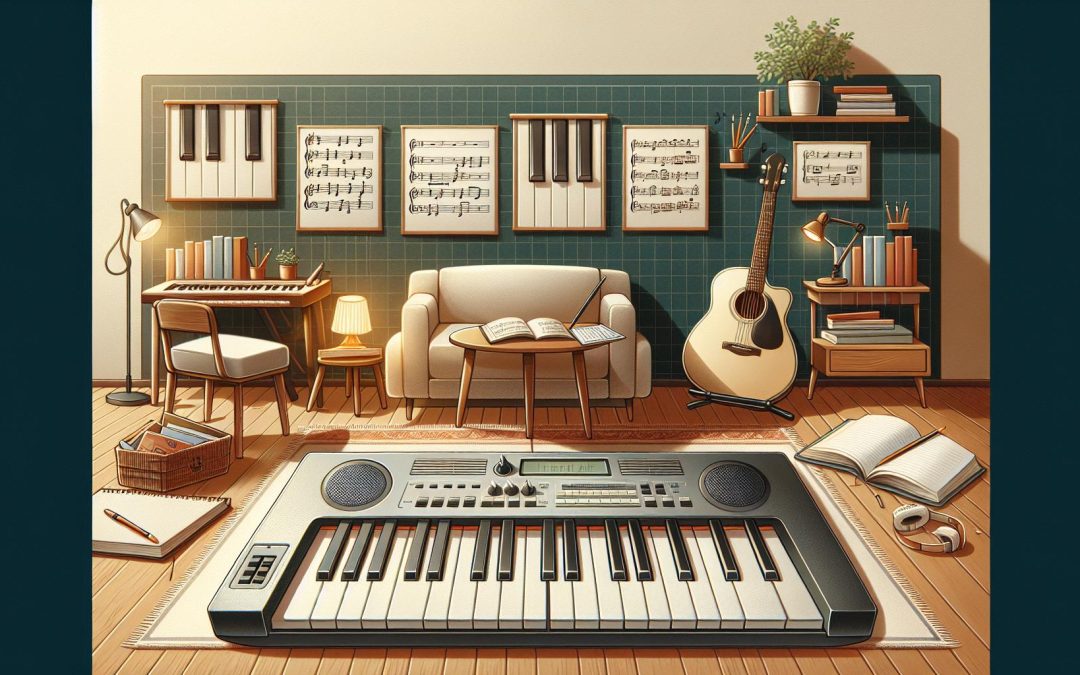Choosing the right keyboard can feel like navigating a maze, especially for beginners. It's not just about the brand or the sound quality; the number of keys plays a crucial role too. Most newbies find themselves torn between the 88 key and the 61 key keyboards, each offering its own set of advantages.
The 88 key keyboard, mirroring a traditional piano, offers a wide range of octaves, making it ideal for those aiming to play classical music or jazz. On the flip side, the 61 key keyboard, with its compact size and fewer keys, might be less intimidating for beginners, offering a more manageable starting point. It's all about finding the right fit for your musical journey.
Pros and Cons of 88 Key Keyboards
When considering the choice between 88 key and 61 key keyboards, it's crucial to weigh the advantages and disadvantages of each. 88 key keyboards, mirroring the traditional piano, come with their own set of pros and cons tailored to the beginner's journey in music.
Pros:
- Full Range: The 88 key keyboard encompasses the full range of a standard piano, offering seven octaves plus a minor third, from A0 to C8. This expansive range is essential for classical and jazz music, where a wide variety of notes and octaves are often utilized.
- Versatility: With the complete set of keys at their disposal, learners can easily transition into different genres of music without limitations. This versatility makes it an excellent choice for those who aim to explore a broad spectrum of musical styles.
- Touch and Feel: Most 88 key keyboards come with weighted keys that aim to replicate the touch and feel of an acoustic piano. This feature is instrumental in developing proper finger technique and dynamics, laying a solid foundation for serious piano students.
- Dynamics and Expression: The ability to convey a wide range of dynamics and expressions is crucial in music. The weighted keys of an 88 key keyboard allow for nuanced control over volume and articulation, enabling musicians to convey emotions more effectively.
- Size and Portability: One of the primary drawbacks of the 88 key keyboard is its size. Being the same length as a traditional piano, it requires considerable space and is not as portable as smaller keyboards.
- Price Point: Typically, 88 key keyboards are more expensive than their 61 key counterparts. The added expense can be a significant consideration for beginners who are uncertain about their long-term commitment to learning the piano.
- Complexity for Beginners: For some beginners, starting with 88 keys can be overwhelming. The wide range of keys and the complexity of managing them can make the learning process more challenging.
| 88 Key Keyboard | Pros | Cons |
|---|---|---|
| Range | Full 7 octaves plus a minor third | |
| Versatility | Suitable for a wide range of music genres | |
| Touch and Feel | Weighted keys replicate acoustic piano | |
| Dynamics | Enables nuanced control | |
| Size |
Pros and Cons of 61 Key Keyboards

When it comes to choosing between 88 key and 61 key keyboards for beginners, understanding the pros and cons of the latter is crucial. A 61 key keyboard, while smaller than its 88 key companion, holds its ground with a unique set of advantages and challenges that cater to different needs and preferences.
One of the major advantages of 61 key keyboards is their compact size and portability. For beginners who might not have a lot of space or who value the ability to easily transport their instrument, a 61 key keyboard is significantly lighter and more manageable. This makes it an ideal choice for those living in small apartments or for younger players whose families need to move the instrument regularly for lessons or performances.
Furthermore, 61 key keyboards often come with a lower price point. This is a particularly attractive feature for those just starting their musical journey. Investing a smaller amount in the initial stages can ease the financial burden, offering an accessible entry point for beginners. Additionally, these keyboards frequently include a variety of built-in learning tools and features such as light-up keys, pre-recorded songs, and even lesson functions. These features can significantly aid in the early stages of music education, making learning both engaging and fun.
However, there are some downsides to consider. One of the most significant is the limited range. A 61 key keyboard covers five octaves, which is sufficient for most beginners but may become restrictive as players advance and wish to explore a wider repertoire. This limitation can hinder the development of certain skills and prevent players from performing complex classical or jazz pieces that require a full seven octaves plus a minor third.
Moreover, while many 61 key keyboards offer touch sensitivity, they rarely include weighted keys. The absence of weighted keys means that players don't experience the resistance of an acoustic piano, which can be crucial for developing proper finger technique and dynamic control. This aspect might necessitate a transition to a more sophisticated keyboard or digital piano as the player progresses, entailing additional costs and adjustments.
Finally, some argue that beginning on a 61 key keyboard might lead to a narrowed perception of piano playing. Without the full range of keys, beginners may not fully appreciate the instrument's versatility or understand how to navigate the transitions between different octaves efficiently. This could potentially limit their overall musical development and understanding.
| Pros of 61 Key Keyboards |
Differences in Sound Range

When comparing 88 key keyboards to their 61 key counterparts, the Differences in Sound Range stand out as a significant factor for beginners to consider. An 88 key keyboard offers a full piano range, from the deep, resonant lows of the bass notes to the crystal-clear highs of the treble notes. This range is not just about more notes but about the capability to express a wider variety of music genres and compositions. Classical pieces, in particular, often require the full range that only an 88 key keyboard can provide.
Conversely, a 61 key keyboard, while sufficiently covering the mid-range notes, misses out on the extreme ends of the piano's spectrum. This limitation means that beginners might not be able to play some of the more expansive pieces of music without adapting them to fit the smaller range. However, it's worth noting that many modern and pop music pieces can be comfortably played within this range. For beginners focusing on these genres, the 61 key keyboard might not feel as limiting.
The impact of the sound range on learning and enjoyment can't be understated. Beginners on an 88 key keyboard have the potential to explore a broader repertoire of music. This exploration not only makes the learning process more enjoyable but also provides a more comprehensive understanding of musical theory and composition. On the flip side, beginners might find the 61 key keyboards less intimidating and more approachable, allowing for a gradual introduction to music playing.
| Keyboard Type | Key Count | Sound Range |
|---|---|---|
| Full-size Keyboard | 88 keys | Full range |
| Smaller Keyboard | 61 keys | Limited range |
Despite the differences, both types of keyboards offer unique advantages. The 61 key keyboards are ideal for musicians who prioritize portability and simplicity. It’s particularly beneficial for those who have space constraints or are always on the move. On the other hand, the 88 key keyboards are unmatched in their ability to provide a full and authentic piano experience, making them a better choice for students who are serious about pursuing music in the long term.
Portability and Space Considerations

When choosing between an 88 key and a 61 key keyboard, especially for beginners, the aspects of portability and space cannot be overstated. Those with limited living space or those who value mobility might find the compact size of the 61 key keyboard particularly appealing. Its lighter weight and smaller footprint make it an ideal choice for musicians on the move or for those living in tight quarters.
On the other hand, 88 key keyboards, which mimic the full range of an acoustic piano, are significantly larger and often heavier. This makes them less portable and requires a dedicated space, not just for the instrument itself but also for a proper seating arrangement that allows for comfortable practice sessions. For someone with ample space and a fixed location where the keyboard can remain set up, the 88 key option is undoubtedly appealing for its extensive musical range and authenticity. However, it's important to consider whether the physical demands of housing such a large instrument align with one's lifestyle and space availability.
The decision between the two types of keyboards also extends beyond the individual's current living situation and touches on future intentions. For beginners who aim to transition to classical piano playing or wish to delve into music genres that demand a broad range of notes, the 88 key keyboard presents a wise long-term investment. Conversely, those seeking to explore music production, electronic music, or simply enjoy the portability of their instrument may find the 61 key variant to suit their needs perfectly.
Moreover, the market today offers innovative solutions to the portability challenge of 88 key keyboards. Certain models are designed to be more compact, with some even featuring detachable sections or foldable designs to aid in transportation and storage. While these features can make an 88 key keyboard more manageable, they might also come with a higher price tag, adding another layer to the decision-making process.
For beginners, it's crucial to weigh these factors carefully. The choice between a 61 key and an 88 key keyboard hinges not just on immediate preferences but on long-term goals and the practicality of instrument size and portability. Whether it's the need for a wide musical range or the flexibility to make music anywhere, there's a keyboard out there that's the right fit for every beginner's journey in music.
Which Keyboard is Right for You?

Deciding between an 88 key and a 61 key keyboard comes down to personal needs, aspirations, and constraints. For beginners, the journey into music should be as enjoyable and frictionless as possible. It's crucial to consider what each type of keyboard offers and how it aligns with one's musical journey.
Assessing Your Musical Goals
First, reflect on your long-term musical goals. If classical piano mastery is the dream, an 88 key keyboard is indispensable. The full range offers a comprehensive learning experience, ensuring that no piece is beyond reach due to limited keys. However, if the goal is to delve into genres like pop, rock, or electronic music, a 61 key keyboard can be more than sufficient. These genres often don't require the full range of an acoustic piano, and the 61 key layout can offer a more manageable learning curve for beginners.
Space and Portability
For those with limited living space or who value the ability to easily transport their instrument, the size and weight of the keyboard are key considerations. Here, 61 key keyboards have a clear advantage:
| Feature | 88 Key Keyboard | 61 Key Keyboard |
|---|---|---|
| Weight | Heavy | Light |
| Size | Large | Compact |
| Portability | Low | High |
The lighter and more compact nature of 61 key keyboards makes them ideal for musicians on the move or those with limited space at home.
Technological Enhancements
Today's keyboards are equipped with an array of features designed to enhance the learning experience. From built-in lesson functions to connectivity with music apps, both 88 and 61 key keyboards come packed with technological advancements. Beginners should explore these features, as they can significantly impact the learning journey.
Budget Considerations
Budget is another critical factor. Generally, 88 key keyboards are more expensive than their 61 key counterparts. They also require additional accessories like stands or benches, which add to the initial investment. Beginners might prefer starting with a 61 key keyboard, which offers a more affordable entry point into the world of music.
Conclusion
Choosing the right keyboard is a crucial step for any beginner stepping into the world of music. It's all about finding that perfect balance between your musical aspirations, the space you have available, and what your wallet allows. If classical music captures your heart, an 88 key keyboard will serve you well with its wide range. On the other hand, for those drawn to pop or electronic vibes, a 61 key keyboard might just be your best bet. Not only are they more compact and easier to fit into smaller spaces, but they're also friendlier on the budget. Remember, both options come packed with features designed to make learning a breeze. So take your pick based on what sings to your soul and your practical needs. Happy playing!
Harlan Kilstein began playing piano during covid with no piano background at all. He taught himself how to play learning what to do and what not to do.
Today he's an advanced intermediate player and can help you grow in your skills because he learned all this on his own.








